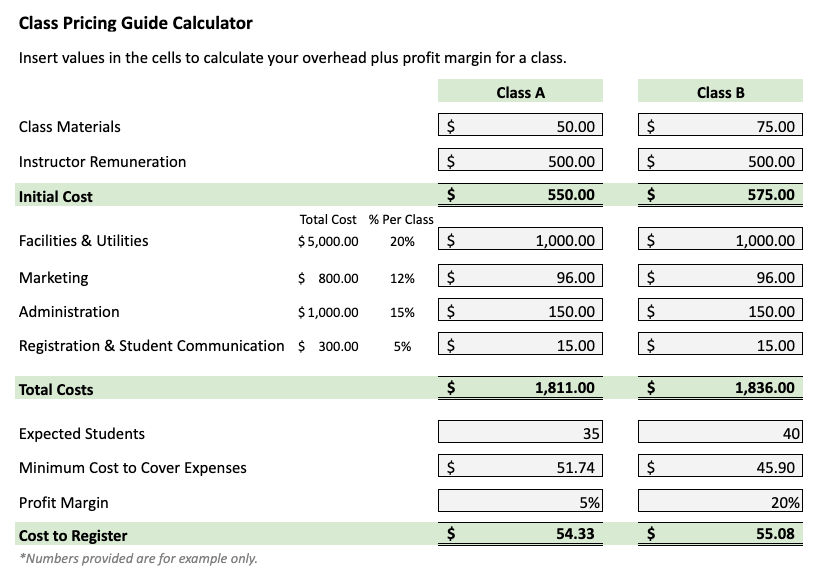Best Practices
How To's
How Much Should a Class Cost? A Simple Pricing Guide

It can be difficult to put a price on a learning opportunity. You want your classes to be accessible to as many students as possible, but you also need to cover your costs. The price you set should acknowledge the value of the offering without giving students sticker shock.
Finding the balance can be tricky, which is why we’ve simplified things with this class pricing guide. While we can’t give you a one-size-fits-all answer for what to charge, we can walk you through what to consider when setting class prices.
3-Step Class Pricing Guide
To make class pricing simpler, we’ve broken the process down into three steps. These steps apply to every type of class or organization. At the end of this pricing guide, you’ll find recommendations for classes offered by nonprofits, different class formats, and special strategies.
Step 1: Calculate Your Overhead Plus Profit Margin
Start by figuring out how much it will cost to offer the class. This includes some obvious things like the cost of materials, but also some less obvious things like the cost of marketing the class.
You may have to make some informed estimates here. The good news is that once you’ve done this, you can use similar figures for every class you offer.
Add up your:
- Class materials
- Instructor remuneration
Then include a percentage of your:
- Facilities and utilities
- Marketing
- Administration
- Registration and student communication
Add all this up and divide by the number of learners you expect to register for the class. This number represents the absolute minimum you can charge in most cases. (We’ll cover the exception in the Special Circumstance section below.) If your organization is for-profit, add in the profit margin you would like to make on the class. Most organizations aim for between 5% and 20% of the cost.
For example: If a class costs you $20 per student and you want to make a 10% profit, you’ll add $20 + (20 x .10) = $22
To make it easy, here’s our customizable Class Pricing Guide Calculator you can modify for your own use.
If you prefer to use Excel, you can download a copy of the calculator.

Step 2: Review the Market
We don’t recommend copying another organization’s pricing structure. You don’t know enough about their business operations to guess if their strategy will work for you. However, it’s still smart to look around at what others are doing.
If your price is much higher than others in your area, learners may not register. If it’s too much lower, they may worry that your class isn’t valuable. Check with others offering similar classes to see what they charge.
A perfect match would be:
- In the same subject
- Offered in your city or area
- Serving the same population
- Offered in the same format
- With the same class size
The reality is that you may not be able to find a perfect match. That’s probably a good thing, because it means that the need is not already filled by that other class.
If you can’t find a perfect match comparison, look for classes:
- At your local college or extension center
- In related subjects
- Offered in a city of similar size to yours
- Serving different populations
- In different formats
- With different class sizes
Note how the class differs from yours and how that might affect the price. For example, classes offered by colleges are often more expensive than those offered by community nonprofits.
Step 3: Consider the Value Your Class Offers Learners
Remember that people tend to see price as an indicator of value. In some cases, lowering the price can actually make your class seem less attractive. It may signal to learners that the class isn’t all that valuable.
Value can be hard to pin down, but in general, you want to consider:
- What skills students will learn
- Whether the class saves them time or money
- If the class makes them more employable by giving them a certificate or credential
- How the class can change their daily life
- What might happen if they don’t take the class
- Other ways they could learn this skill or gain this knowledge
A few other factors can affect value, including the number of students per class. Bigger class sizes generally equal lower value. Instructor reputation can also play a role. For example, students may be willing to pay more to take a writing class from an award-winning author.
Adjusting the Pricing Guide for Special Circumstances
If you’ve followed the three steps above, you should have a ballpark idea of what your pricing should be. If your organization is a nonprofit, offering online classes, or wants to attract more students, read on for extra guidance.
Pricing Guide Considerations for Nonprofit Organizations
When setting pricing, nonprofits should consider the purpose of their classes. If classes are core to your mission, you may want to make some classes free or charge a nominal fee. Some nonprofits offer classes that are an extension of their mission and can help to fund more essential functions. In that case, you’ll want to do more than just cover the cost of the class.
In-Person Versus Online Classes
Whether a class is online or in-person can impact the perceived value. Online classes may face more competition, since students have access to sites like Coursera, EdX and even YouTube. You may need to match these prices, or make an extra effort to prove why yours are more valuable than these large-scale offerings.
One way to show value is by marketing to students in your local area. Lean in to the idea that they’re supporting a community nonprofit or small business. If you have an office where they can call or walk in for support, that’s even better.
Special Pricing to Attract More Students
In some cases, low cost or even free classes can pay off for your program. They can encourage people to try your classes. Many dance, fitness, and yoga studios do this as a way to get more people to try out their offerings.
If you choose to offer a loss leader class, pick it carefully. It should be an introductory level course that accurately represents what your program offers. You might even create a special survey or intro course for this purpose.
Don’t Forget a Yearly Pricing Review!
Remember that class pricing isn’t like a rotisserie oven, you can’t just set it and forget it. Do a pricing review every year or so to make sure your classes are still well-priced for the market and matched to the class value.
Review your prices every year to make sure your classes are still well-priced for the market and matched to the value they offer.
If you think it might be time to raise your prices, don’t worry. We have a guide for that too. Learn how you can raise prices without upsetting students.

Nic Lyons
Nic is skilled in scaling start-up edtech and education organizations to growth-stage success through innovative marketing. A former journalist and copywriter, Nic holds a postgraduate certificate in digital and print publishing from Columbia University School of Journalism's publishing course.
